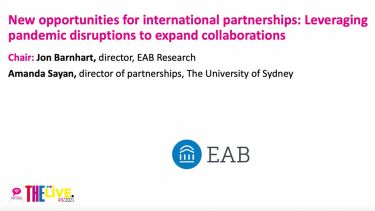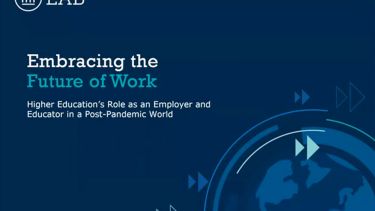The pandemic has disrupted many aspects of university life. For international students, however, it has caused upheaval that will continue for years to come
If there is one theme that higher education institutions constantly raise as they move towards a post-pandemic world, it is volatility. Perhaps now more than ever, institutional leaders are grappling with uncertainty. However, while much of this disruption can be attributed to the Covid-19 pandemic, other factors, including geopolitical shifts and demographic trends, are also to blame.
During a Times Higher Education webinar, senior leaders from EAB – a provider of research, technology and consulting in the education sphere – discussed how the pandemic has impacted the preferences and intentions of international students and how institutions should react.
“Back in early 2020, the ability to contain the spread of Covid-19 was a major factor for an institution’s international standing,” Larisa Hussak, senior director of EAB Research, explained. “However, 18 months on, the landscape is very different. Student preferences have shifted much more to the experiential – including opportunities to study in person.”
The panel then assessed how anglophone institutions had been impacted by the pandemic. “Starting with Canada, international enrolment has risen consistently over the last decade,” said John Workman, managing director at EAB Research. Strategic investment, allied to the fact that most institutions are now offering face-to-face learning and on-campus living, has given Canada a very positive outlook in terms of post-pandemic enrolment.”
“While the UK continues to inhabit a largely positive position, the shadow of Brexit cannot be ignored,” Hussak continued. “Behind recent enrolment growth is a 43 per cent decline in applications from the European Union between 2020 and 2021. Unfortunately, this fall is only likely to become more significant over time.”
“In contrast to the UK and Canada, international enrolments in the US have been declining quite rapidly for some time, partly due to policies of the Trump administration and growing tensions with China,” Workman commented. Australia and New Zealand, meanwhile, continue to face challenging market conditions because of some of the most stringent Covid restrictions in the world. More than any others, these markets can truly be deemed to have lived a pre- and post-pandemic story.
Three factors are likely to shape the higher education market over the next five or so years: the end of unfettered travel, price sensitivity hitting a peak, and a higher bar for postgraduate outcomes.
“Some institutions are forming international partnerships to mitigate the impact of ongoing travel restrictions, while virtual recruitment will likely continue to play a core role,” Hussak said. “This is despite the mixed response that virtual engagement has had thus far. The future of virtual recruiting success, therefore, will depend on universities’ ability to deploy design principles to effectively meet student needs.”
Finally, institutions must find new ways to appeal to price-sensitive students by taking innovative approaches to pricing and aid. They will also be under increasing pressure to demonstrate that their educational experiences will lead to stable, well-paid jobs for their students. Of course, there are no quick fixes to these challenges, but taking a holistic approach will help temper any ongoing volatility.
The panel:
- Larisa Hussak, senior director, EAB Research
- John Workman, managing director, EAB Research
Find out more about EAB.








